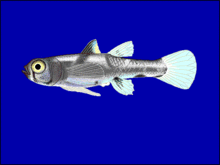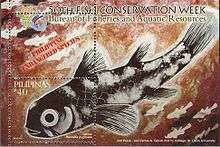Dwarf pygmy goby
| Dwarf pygmy goby | |
|---|---|
 | |
| Scientific classification | |
| Kingdom: | Animalia |
| Phylum: | Chordata |
| Class: | Actinopterygii |
| Order: | Perciformes |
| Family: | Gobiidae |
| Subfamily: | Gobionellinae |
| Genus: | Pandaka |
| Species: | P. pygmaea |
| Binomial name | |
| Pandaka pygmaea Herre, 1927 It measures 1.5 mm in length. | |

The dwarf pygmy goby or Philippine goby[2] (Pandaka pygmaea) is a tropical freshwater fish of family Gobiidae. It is one of the smallest fish in the world by mass, and is also one of the shortest freshwater fish. Mature males can reach up to 1.1 centimetres (0.43 in) SL, while the females can grow up to 1.5 centimetres (0.59 in) SL. Average weight is from 4 to 5 milligrams (0.00014 to 0.00018 oz). It is known as bia and tabios in the Philippines.[3][4][5]
Distribution and habitat
P. pygmaea is primarily a Philippine species that was endemic in the rivers of Malabon, Metro Manila. It used to frequent shady river banks in Rizal Province of Luzon, Philippines. It has also been collected in the sea at Culion Island, near Palawan, Philippines. It also thrives in brackish waters and mangrove areas of Indonesia and Singapore (1992). It had been imported into Germany in 1958.[3][4][5]
Dwarf pygmy gobies survive in demersal, freshwater, brackish and marine water environments at a pH ranging from 7.0 – 8.4, a dH range of 30, and at tropical temperatures measuring from 24 to 30 °C (75 to 86 °F).[3][4][5]
Appearance and anatomy
A colorless and nearly transparent species, the dwarf pygmy goby has a moderately elongated and robust body. Males are slender with nearly straight dorsal and ventral profiles, while the females appear stouter with the dorsal profile slightly curved, the belly protuberant, and the ventral outline strongly arched.[3][4][5]
The head of the P. pygmaea is large and blunt. The head and nape are naked. The upper and lower profiles converge and are pointed if viewed from the sides. The head is characteristically broader than deep. The head is very short, broad and rounded. The mouth is very oblique, with a projecting lower jaw and chin. The posterior angle of the maxillary extends beneath the anterior part of the eye, up to the middle of pupil. It possesses two rows of teeth in each jaw. The outer row of teeth inside the upper jaw is larger and more widely spaced, while the inner row is characteristically minute. The first dorsal fin is low, much in advance of the second dorsal fin but not reaching the second dorsal fin when depressed. The pectoral and ventral fins are pointed, with the latter about as long as the former or longer. The anal papilla is very short and rounded in females, but is longer and very slender in males.[3][4][5]
P. pygmaea have dark spots, which forms 4 cross-bands, over the sides of its body. The bases of the fins are heavily pigmented, except for the ventral fins. It has 22 to 25 scales in longitudinal series.[3][4][5]
Ecology
The species is considered vanishing or extinct in the Philippines due to polluted local waters or land reclamation projects.[3][4][5]
Feeding
This species feeds on plankton.[3][4][5]
Reproduction
P. pygmaea is an oviparous species.[3][4][5]
Miscellaneous
Pandaka pygmaea was once portrayed on a Philippine ten centavo coin where, uniquely for a wildlife portrayal on coinage, it is depicted at life-size. The genus name is derived from the Filipino word pandak, meaning "dwarf" or "short of stature".[6]
See also
References
- ↑ World Conservation Monitoring Centre 1996. Pandaka pygmaea. In: IUCN 2013. IUCN Red List of Threatened Species. Version 2013.1. <www.iucnredlist.org>. Downloaded on 13 September 2013.
- ↑ Animals. pawnation.com
- 1 2 3 4 5 6 7 8 9 Från. Pandaka pygmaea (Herre 1927), Guide to the Philippine Flora and Fauna, Band IX, ISBN 971-10-2627-9 (undated), retrieved on: July 14, 2007
- 1 2 3 4 5 6 7 8 9 Froese, Rainer and Nicolas Bailly. Pandaka pygmaea, Dwarf pygmy goby, Filaman.ifm-Geomar.de, 1988 and 1997 retrieved on: July 14, 2007
- 1 2 3 4 5 6 7 8 9 Capuli, Estelita Emily, Arelene G. Sampang, Arlene G. and Rainer Froese, Pandaka pygmaea in Philippines, Dwarf pygmy goby, Country Species Summary, FishBase.org, retrieved on: July 14, 2007
- ↑ "Pandak". WikaPinoy.com.
External links
| Wikimedia Commons has media related to Pandaka pygmaea. |
| Wikispecies has information related to: Gobiidae |
- Biblio Summary, Filaman.ifm-Geomar.de retrieved on: July 14, 2007
- Photograph and Description of Pandaka pygmaea, Herre, 1927, Dwarf pygmy goby, Pandaka pygmaea, NSMT-P 66047, 1.0 cm SL, Fishes of Libong Island, Kahaku.Go.jp, retrieved on July 14, 2007
- Pandaka pygmaea, Herre, 1927, Taxonomic Serial No.: 172193, ITIS.gov, retrieved on: July 14, 2007
- Chen, Loris. Gobies: Going, Going, Gone? A WebQuest for 6-8th Grade (Science) ([email protected]), Ocean Biographic Information System, Census of Marine Life, Rutgers, The State University of New Jersey, 2002-2007. IOBIS.org, retrieved on July 14, 2007
- Fenner, Bob. "True" or Combtooth Gobies, the Family Gobiidae, Wetwebmedia.com (undated), retrieved on July 14, 2007
